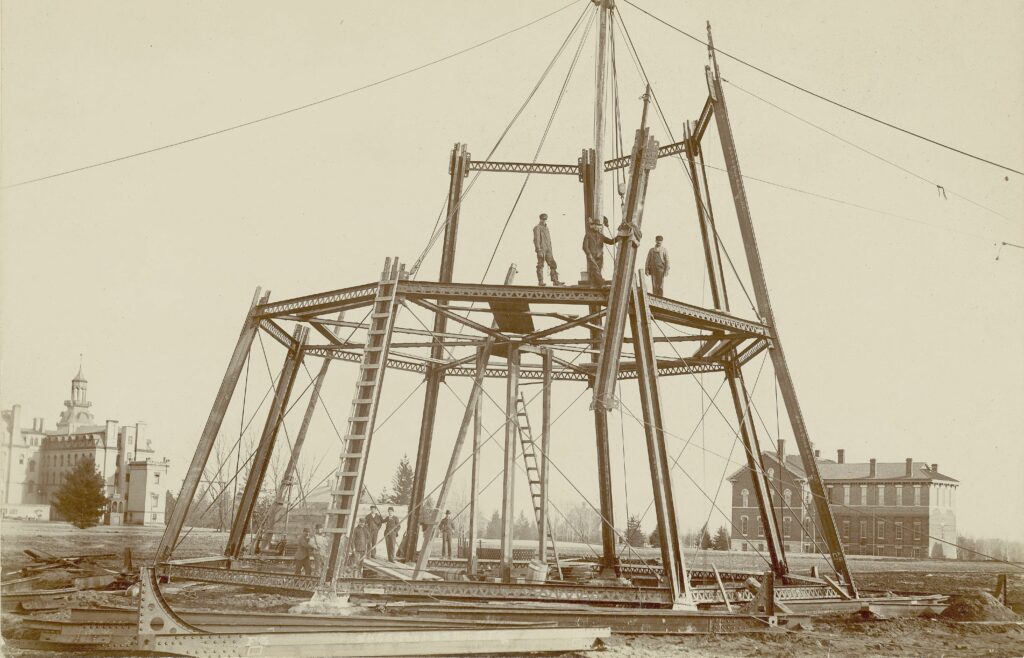
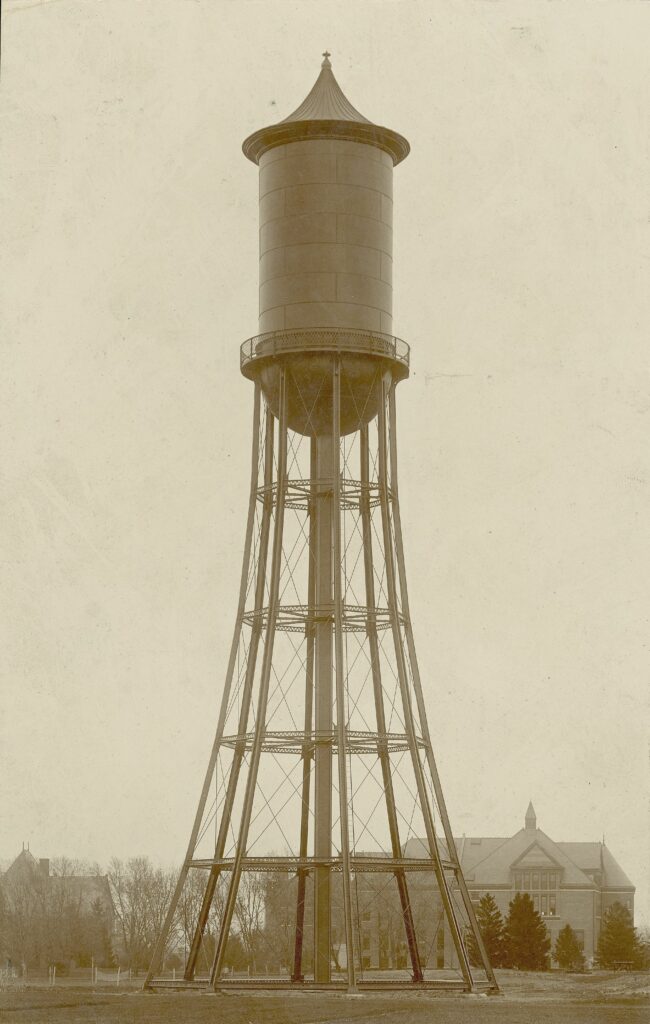
About the Art
The decision to build Marston Water Tower was made in 1895, one year after a severe water shortage forced the cancellation of classes.
Designed by Iowa State professor Anson Marston and built in 1897, the Marston Water Tower was the first and tallest above-ground steel water tower west of the Mississippi River. Standing 168 feet above campus, the tank itself is 40 feet tall and 24 feet in diameter and held 162,000 gallons. It is octagonal in base shape.
Use of Marston Water Tower was discontinued in 1978 when Iowa State University switched to the city water system. Marston Water Tower was placed on the National Register of Historic Places in 1981. It was restored in 1997. In 2007 the American Water Works Association presented Iowa State University an award naming Marston Water Tower an “American Water Landmark.
Marston Water Tower represents the creativity, imagination and innovation that inspires Iowa State engineering graduates to build and design environments where people around the world work, live and thrive.
Relevant Terminology/History
A water tower is an elevated structure supporting a water tank constructed at a height sufficient to pressurize a distribution system for potable water, and to provide emergency storage for file protection. The upper portion of water is skimmed off the top for everyday use while the water in the bottom of the tower is held in reserve to fight fire. When the water drops below a certain level, a pressure switch, level switch, or float valve activates a pump or open public water line to refill the water tower.
Water towers work by pumping clean, treated water up into the tower. When the region needs water, water pumps utilize the pull of gravity to provide high water pressure. Most tanks are sized to hold at least one day’s worth of water for the community served by the tower. If the pump fails (i.e., power failure), the water tower holds enough water to keep things flowing for about a day.
Water is a substance composed of two elements hydrogen (H) and one element of oxygen (O); it is written chemically as H2O. Water exists in gaseous, liquid, and solid states and is one of the most plentiful and essential compounds. Life is believed to have originated in the aqueous solutions of the world’s oceans. Living organisms depend on aqueous solutions for biological processes.
Fun Fact: The average human body is 60-65% water. It can vary from 45%-75%.
The Rime of the Ancient Mariner by Samuel Coleridge, 1834 includes the famous lines:
“Water, water everywhere
Nor any drop to drink.”
The lines describe the life-threatening situation of being on a boat surrounded by saltwater but no fresh water to drink. Due to river and lake levels dropping, there is increased interest in de-salination to turn sea water into drinkable water.
Because of its necessity to maintain organic life, all cultures learned to obtain fresh water to survive. Prior to creating water towers to store water, humans tapped wells, located aquafers, collected water from streams, fresh lakes, and rainwater in buckets, and created methods to transport water to where they wanted to live and grow crops or raise livestock. Scientists have tried to “seed clouds” to produce rain.
Ancient cultures created many approaches to supply drinking water, irrigation, baths, and public fountains. Many were major feats of engineering that resulted in being named as unique or part of a group UNESCO cultural. Below are short discussions of each of the following technical and architecturally-significant illustrations of human technological inventions:
- Alflaj irrigation system of Oman and Iran;
- Qanat system from China to Morocco; and
- Roman aqueducts.
Aflaj irrigation system of Oman
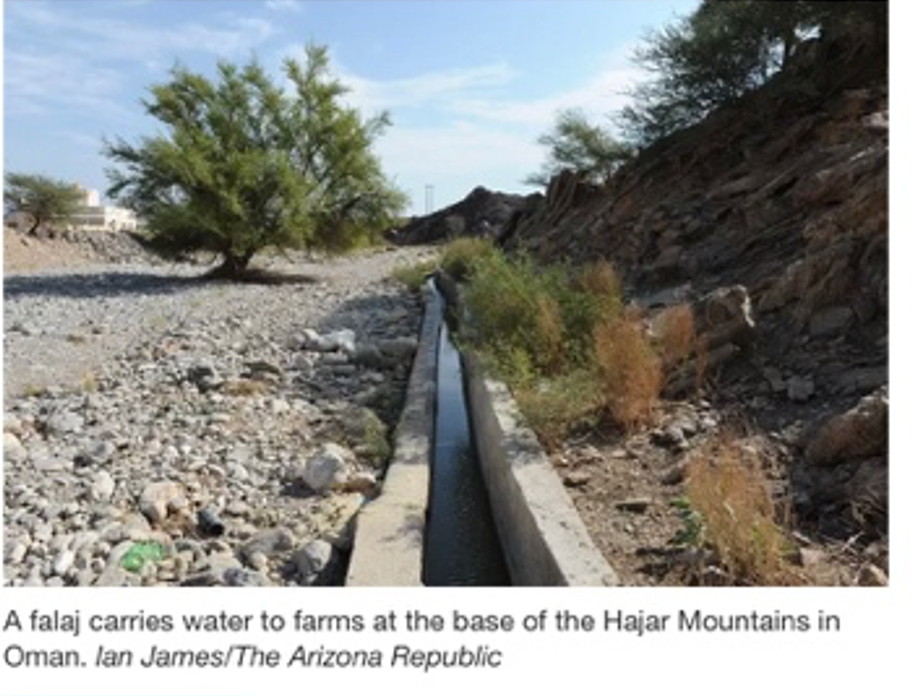
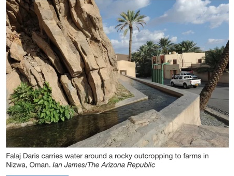
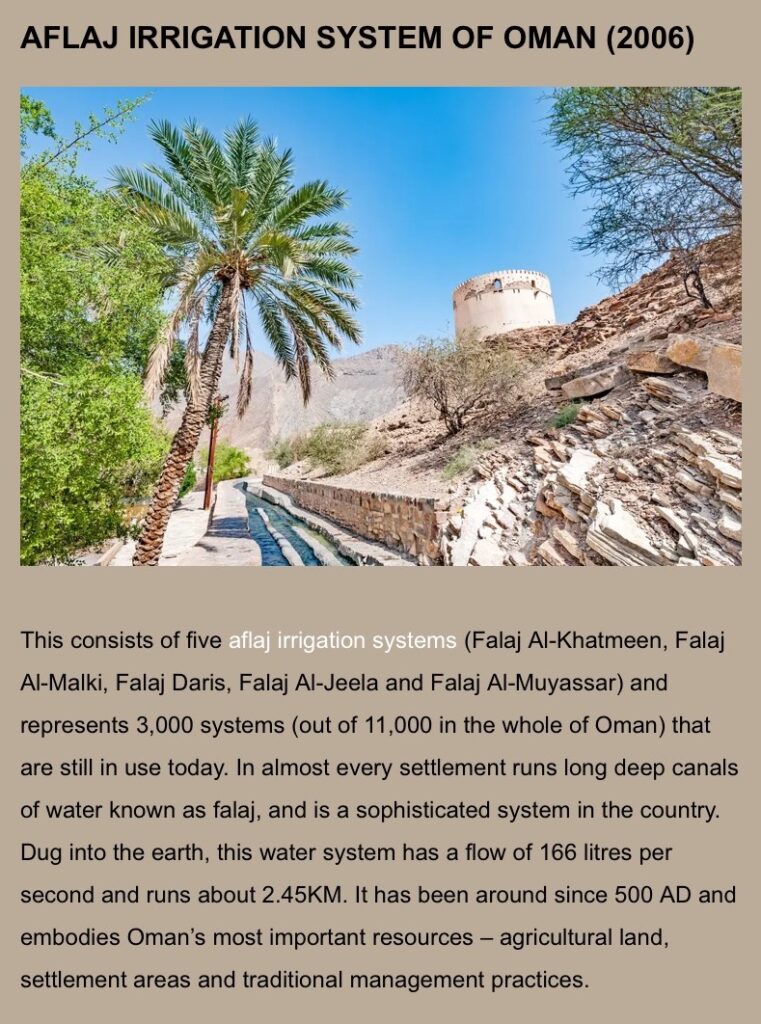
Oman and Iran (across the Straits of Hormuz) developed flowing water tunnels called falaj (aflaj for multiple channels), many of which are still in existence today. The system involved tapping into springs on the mountain slopes, digging tunnels by hand to reach underground water sources and capture what flowed from the rocks and earth. Channels were built with stones and mortar to carry the water downhill to their homes and terraced fields. The aflaj are among the world’s oldest functioning water-sharing systems. Researchers have traced the systems back to the Bronze Age, more than 3,000 years ago. The Oman aflaj system was added to UNESCO‘s list of World Heritage sites in 2006 because of its exceptional preservation and historical importance.

Although difficult to see, the pipes are near the old system in areas of reconstruction in the mountains of Oman. Photo courtesy of Dr. Klemm on her trip to Oman in February 2020.
In the early part of the first millennium BCE, Persians started constructing elaborate tunnel systems called qanats for extracting groundwater in the dry mountain basins of present-day Iran. Qanat tunnels were hand-dug, just large enough to fit the person doing the digging. Along the length of a qanat, which can be several kilometers, vertical shafts were sunk at intervals of 20 to 30 meters to remove excavated material and to provide ventilation and access for repairs. The main qanat tunnel sloped gently down from pre-mountainous alluvial fans to an outlet at a village. From there, canals would distribute water to fields for irrigation. These amazing structures allowed Persian farmers to succeed despite long dry periods when there was no available surface water. Many qanats are still in use stretching from China on the east to Morocco on the west, and even to the Americas.
As of 2023, Qanats of Persia remains under review by the UNESCO team to include Persian Qanat to UNESCO‘s list of World Heritage sites.
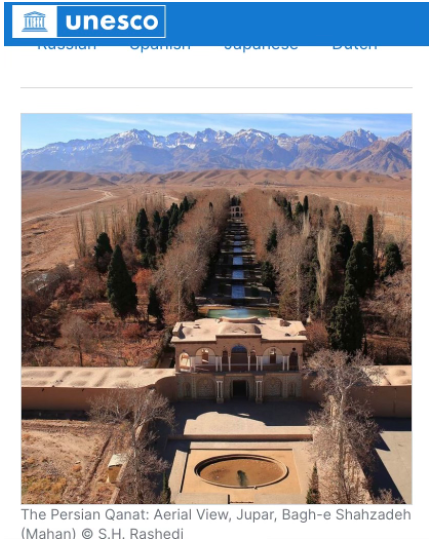
*Fun Fact: The Chinee developed ingenious water-lifting devices such as the chain pump, rope pump, and valved buckets to expediently draw water from deep wells.
An aqueduct is an artificial channel for conveying water, typically in the form of a bridge across a valley or other gap. Gravity and natural slopes of the land allowed aqueducts to channel water from a freshwater source, such as a lake or spring to a city.
Both ancient Mesopotamia and the Minoan Civilization on Crete used aqueducts in the 2nd millennium BCE made of clay tiles.
The most famous aqueducts were developed by the Romans. Two famous Roman aqueducts include the Pont Du Gard in Nimes, France and Aqua Virgo ending in Rome, Italy.
Pont Du Gard is a triple bridge design over the Gardon River. It was built during the first century CE at 48.8 meters high, making it one of the tallest in the world. It was added to UNESCO‘s list of World Heritage sites in 1985 because of its exceptional preservation, historical importance, and architectural ingenuity.
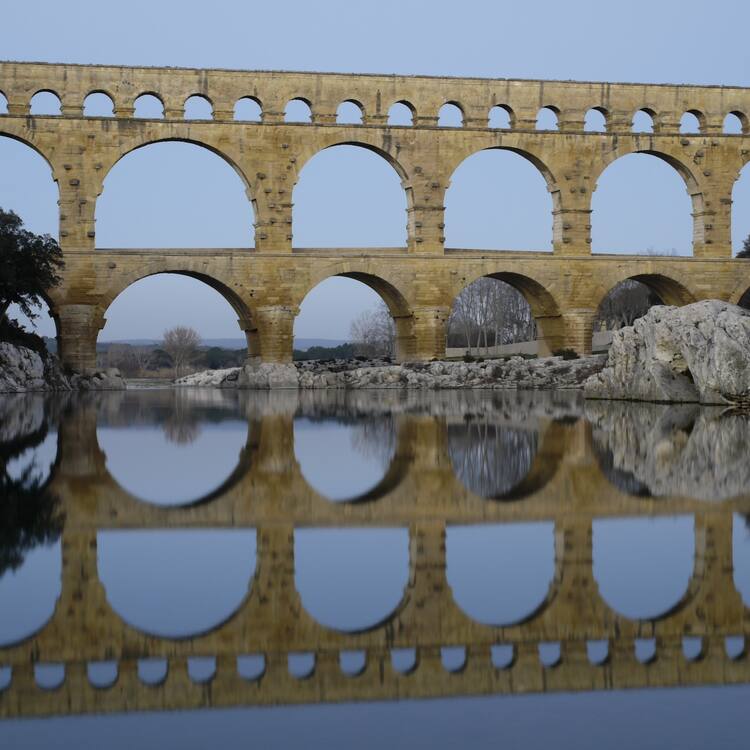
Pont Du Gard, Nimes, France, image courtesy of Wikipedia
Aqua Virgo was one of the first aqueducts to bring water to Rome. It was originally built in 19 BCE during the reign of Emperor Agustus. After the fall of the Roman Empire, it fell out of use. During the Renaissance it was renovated to transport 80,000 cubic meters of fresh water into the Trevi Fountain. It remains the source of water for the Trevi Fountain.
The Trevi Fountain (Fontana di Trevi) is part of the Historic Center of Rome that is UNESCO UNESCO‘s list of World Heritage sites in 1980 because of its exceptional preservation, historical importance, and architectural ingenuity. The tradition of tossing coins into Trevi Fountain dates back to the mid-20th century and has become one of Rome’s most popular tourist rituals. According to legend, tossing a coin into Trevi Foundation with your right hand over your left shoulder will ensure your return to Rome. Other legends support successful love or wealth/prosperity upon tossing three coins into Trevi Fountain. The popularity of the tradition of tossing coins into Trevi Fountain after being featured in the 1954 film, “Three coins in the Fountain.”
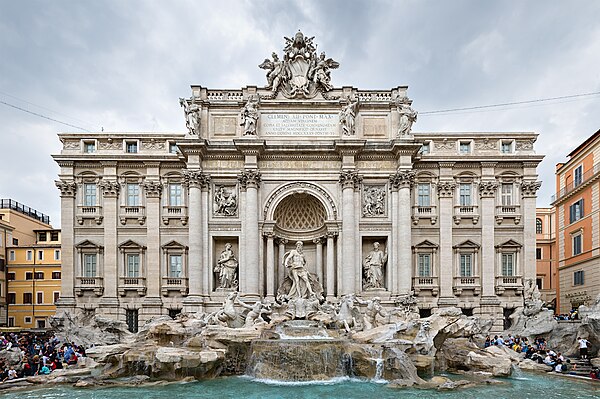
Trevi Fountain, Fontana di Trevi, 1732–1762, Rome, Italy, image courtesy of Wikipedia.
*Fun fact: Tossed coins are collected nightly. Millions of Euros are collected annually and are used to support Rome’s charitable organizations.
Learning Guide
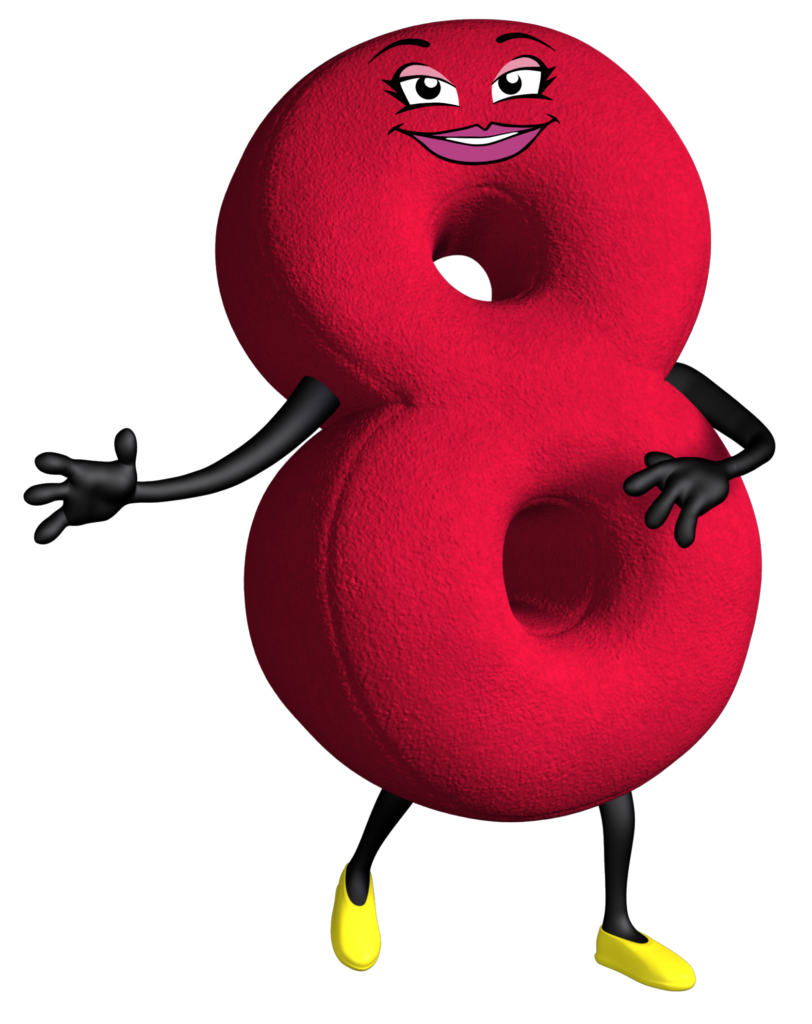
- How does the title relate to the structure?
- What is the base shape of Marston Water Tower? Is it a symmetric base shape? If so, how is it symmetric?
- How does the red image with white numbers relate to the book? Where can you find that image in the book?
- How does the hidden blue image relate to Marston Water Tower?
- Have you ever seen a blueprint before? If yes, what kind of structure was the blueprint for?
- What kind of professional creates blueprints?
- What is the approximate shape of the cross-section top of Marston Water Tower drawn in the blueprint?
- How many “levels” create the tank? (Hint: The levels that look like “bricks” in the blueprint diagram.)
- How many levels are there below the tank platform? Do you see a pattern in the length of the diameters of the levels from the bottom one to the last one below the platform?
- What do you think the purpose of the small circle in the center of the lower right drawing of the blueprint for Marston Water Tower?
- What do you think the purpose of the “x” wires are for in each quadrilateral from the bottom to the platform below the tank?
- How many individuals can you see working on Marston Water Tower in the top left image?
- What kind of clothing are the workers wearing?
- Do you know where Oman is? Did you know it is mostly two major separated land masses (one is across from Iran via the Straits of Hormuz and the other is on the southeastern coast of the Arabian Peninsula) that joined together when Arab tribes could vote to join United Arab Emirates (UAE) or Oman in 1971?
- Do you think “aflaj” and “qanat” might be good Scrabble words? Why?
- Do you know where and when the Persians lived?
- What shape is the basis of the Pont Du Gard aqueduct? What do you think people used the aqueduct for during the Middle Ages?
- Do you think the aflaj or qanat systems or aqueducts brought safe drinkable water in addition to water suitable for farming? Why?
- How much water is suggested for you to drink each day?
- What do you think happens to the plastic water bottles recycled daily?
- What red sign do you see frequently that is octagonal in shape? Do you think that had any influence on why Dr. Klemm created Team Ten Character 8 as red?
